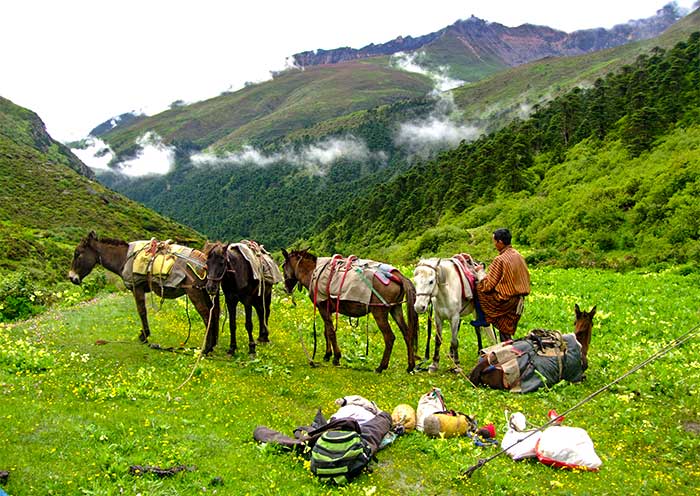- Highlights
- Itinerary
- Price
- Trip Notes
- Accommodation
- Photos
- Reviews
Jomolhari Trek ranks among Bhutan's most popular trekking routes. Its crown jewel? Breathtaking panoramas of the magnificent 7,314-meter Mt. Jomolhari, unveiled from the serene Jangothang Base Camp.
Bhutan's mountains are not as famous as the 8,000-meter-plus peaks in Nepal and China, but they are rugged and beautiful. Jomolhari Peak was an important landmark in the early days of Mount Everest exploration. When the British Mount Everest Expedition was marching at its foot in 1921, George Leigh Mallory described it as "surprisingly and magnificently grand," but felt "cold and fearful".
Jomolhari Trek is one of the most sought-after trekking destinations in Bhutan. It is also known as Chomolhari or Jumolhari Trek in Bhutan. The panoramic views of the Jomolhari mountain are a major highlight of this 11-day trek. The trek offers a once-in-a-lifetime opportunity to experience the true monastic life and remarkable landmarks with amazing architecture. Even the ruins of the age-old monasteries throughout the trek take you back in time and introduce you to the true Bhutan. The trek, which takes an average of 5-6 hours a day, is not as difficult as others in Bhutan. Most of the trekking destinations pass through farmlands, pastures, and forests. On the way to Jangothang, you observe the lifestyle of the Bhutanese people living in small villages of Sio, Takethang, and Dangochang. The villages have traditional houses that reflect the rural side of Bhutan.

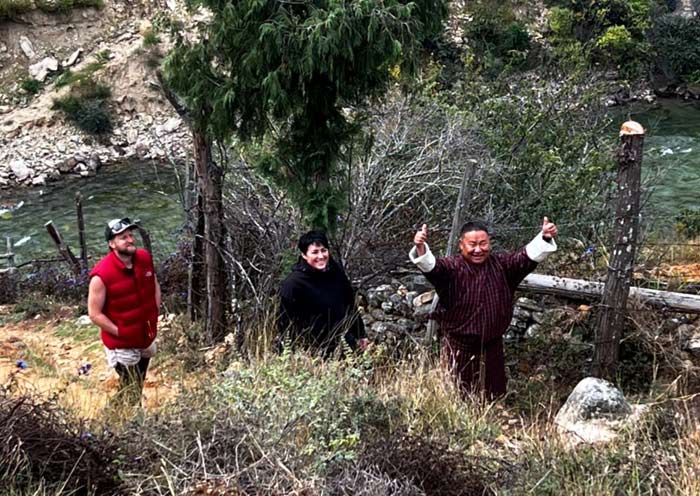





Itinerary at a Glance
Jomolhari Trek (7 Days)
Highest Altitude: 4930 meters
Difficulty: Moderate to high
Season: April to June, September to November
Starting Point: Sharna Zampa
Endpoint: Dodina
Departure Towns: Paro, Thimphu
Paro (3.5 Days)
Tiger's Nest Monastery (Taktsang Goemba, Paro Taktshang), Kyichu Lhakhang, Rinpung Dzong (Paro Dzong), Bhutan National Museum (Ta Dzong)
Thimphu (2 Days)
Buddha Dordenma Statue, National Memorial Chorten, Tashichho Dzong (Thimphu Dzong), Motithang Takin Preserve, Folk Heritage Museum
Itinerary Day by Day
Welcome to Bhutan, the Last Shangri La in Pristine Himalayan Kingdom. Take a deep breath and enjoy the refreshing breeze in the happy country where 71% of the land is covered with forests. Your guide and driver in Paro will greet you at Paro International Airport, Bhutan's only international airport.
Paro (2,270m) is the first city for most guests to reach Bhutan. It is known for Tiger's Nest which makes Paro a must-visit destination in Bhutan. For nature and culture lovers, Paro is a picturesque place that combines spirituality, natural beauty, and cultural heritage. You will not miss a stop at the Paro Airport Birds Eye View Point on the way to you hotel, which is a great spot to enjoy a panorama view of Paro Airport, Rinpung Dzong (Paro Dzong), National Museum (Ta Dzong), Paro Chu River, and the stunning Paro Valley itself. Don't forget to ask your guide for more fascinating information about this remarkable airport. Afterward, you can check in at your cozy hotel, where you can rest and acclimate yourself to any time difference.
In this afternoon, you will have the opportunity to visit Paro Dzong (Rinpung Dzong). This magnificent fortress stands tall and proud, serving as a beacon of history and culture in Bhutan. Rinpung Dzong was constructed in 1646 by Shabdrung Ngawang Namgyal (1594-1651), a pivotal figure in Bhutanese history who is revered as the founder of the modern Bhutanese state and a national hero. His enduring legacy continues to shape the country's identity and cultural landscape. Located near the pristine Paro Chu River, Paro Dzong can be accessed via a traditional wooden cantilever bridge, providing you breathtaking panoramic views of the enchanting Paro Valley.
If you hike a little further, you will reach the Bhutan National Museum (Ta Dzong), which holds the distinction of being Bhutan's tallest building. Originally constructed in 1649 as a watchtower overlooking the Paro Dzong, it was later transformed into the National Museum of Bhutan in 1968. At the museum, you can immerse yourself in a rich collection of ancient artifacts such as pottery, armor, thangkas, masks, stamps, photographs, statues, costumes, relics, stone axes, and religious paintings.
Note: Please note that Paro Dzong is open from 9 AM to 5 PM on weekdays and from 10 AM to 4 PM on weekends. If you can't make it to the opening hours, we suggest visiting the Paro Local Market instead. It's a place where locals and tourists alike come to shop for traditional Bhutanese handicrafts, textiles, jewelry, and other local produce. It offers a glimpse into the daily life and culture of Bhutan.
Arrival Ideas:
Bhutan is situated between Tibet in China to the north and India to the south. To reach Bhutan, you can either travel by air to Paro International Airport, the country's only international airport, or by land through the entry points of Phuentsholing or Gelephu from India. Bhutan's national carrier, Druk Air, Bhutan Airlines, and other international airlines operate regular flights to Paro from major cities like Delhi (India), Kolkata (India), Bagdogra (India), Gaya (India), Guwahati (India), Dhaka (Bangladesh), Bangkok (Thailand), Kathmandu (Nepal), and Changi (Singapore). There are also some charter flights to Paro from Hong Kong (China) and Kuala Lumpur (Malaysia) on a seasonal basis. Around 30,000 people arrive at Paro Airport every year.
Kind Reminds:
1. You can contact us to book your flight to Paro and land directly in Bhutan.
2. Visitors of all nationalities, except those from India (require a permit), require an E-visa (40USD/pax) before entering Bhutan. All nationalities are welcome to visit Bhutan, and there are no specific restrictions on granting visas to enter the country.
3. Visitors from India are able to apply for a permit but are required to hold an Indian passport or an Indian voter ID card.
4. Visitors from Bangladesh and the Maldives also require a visa, which can be applied for and approved in advance of travel or upon arrival in Bhutan.

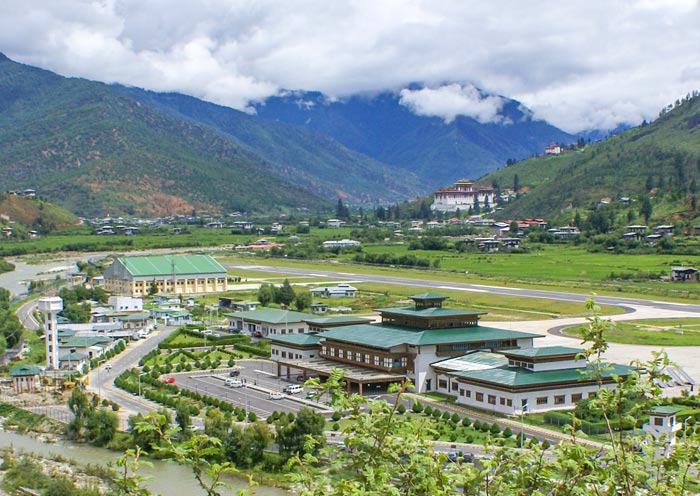

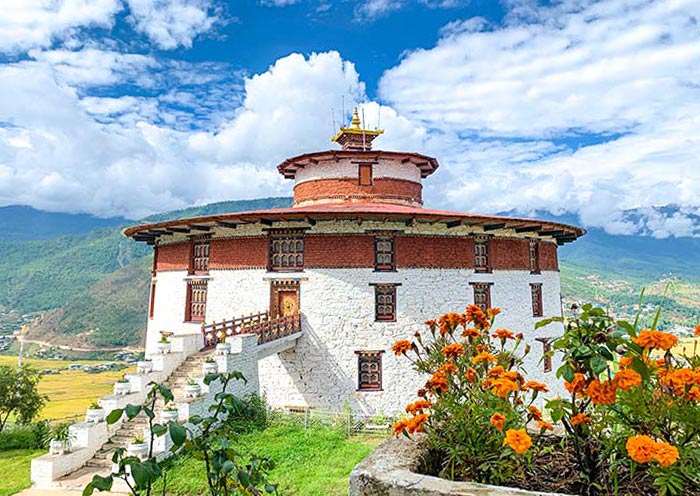
This morning, you will enjoy the exciting hiking tour to Tiger's Nest, the landmark of Bhutan and the most famous holy monastery in the country. It is about a 12km drive (over 0.5 hours) from Paro City to the start point of the Tiger's Nest hike route.
Usually, it may take about 2.5 hours to reach Tiger's Nest Monastery (Paro Taktsang) on foot. The entire Tiger's Nest Hike takes around 5 to 6 hours, with about 4.8 km of uphill trekking and about 4.8 km of downhill walking. You have the option to rent a horse at the designated place if you prefer. Riding a horse (self-payment required) takes about 1.5 hours to reach the halfway point on the mountainside. From there, you need to say goodbye to your horse and hike for another 1.5 hours to reach the Tiger's Nest Monastery. At the halfway point, there is a Taktsang Cafeteria where you can have a buffet lunch and enjoy coffee and tea. What is more, it is the first viewpoint where you can look up Tiger's Nest Monastery, the incredible religious site of Buddhists. As the viewing position ascends, the outline of Tiger's Nest Monastery becomes increasingly clear. On the journey ahead, you can enjoy the hike in Bhutan’s forest and will see more and more prayer flags and prayer wheels, left behind by the Bhutanese people who come here to worship. You will also have a panoramic view of the beautiful Paro Valley below. If you visit in April, you will have the opportunity to see the high-altitude rhododendrons blooming, creating a stunning display of red clouds amidst the mountains.
Then, you will stand right opposite the Taktsang Goemba (Tiger's Nest Monastery) and admire Bhutan's most iconic cultural landmark, which is renowned as one of the world's top ten super monasteries. The Tiger's Nest (3,120m) is situated on the side of a cliff at a height of 900m above the Paro Valley (2,270m). According to legend, the Indian sage Guru Padmasambhava (Guru Rimpoche, the founder of the Nyingma school of Tibetan Buddhism and the builder of the first monastery in Tibet - Samye Monastery) arrived at the location of Tiger's Nest Monastery in the 8th century. It is said that he rode a tigress and subdued demons before spending 3 months meditating in the mountain caves here. This eventually led to the formation of the present-day Tiger's Nest Monastery. Throughout history, this place has been considered a sacred site by Buddhist luminaries. However, it wasn't until 1692 that the current structure of Tiger's Nest Monastery took shape. In 1998, a devastating fire caused significant damage, but it was reconstructed in 2005, closely resembling the original architectural design. If you are interested you can hike into the monastery to explore more (no photo inside). Today, Tiger's Nest Monastery, one of the most visited tourist attractions in Bhutan, is revered as the holiest pilgrimage site for Bhutanese people to visit at least once in a lifetime.
After completing the Tiger's Nest hike, you will proceed to Drukgyal Dzong, where you will have the opportunity to catch a glimpse of Mount Jomolhari (7,570m). Known as the "Mountain Goddess" and the tallest mountain in Bhutan, Mt Jomolhari is considered a sacred abode for deities and spirits, earning the title of "Sacred Mountain". Know as the Fortress of the Victorious Drukpa, Drukgyal Dzong was believed to have been built in 1646 by Zhabdrung Ngawang Namgyal who is the unifier and founder of the Bhutanese nation-state. The building was used as an administrative center until 1951 when a fire caused by a butter lamp destroyed it. In April 2016, to celebrate the birth of the Dragon Prince, Gyalsey His Royal Highness Jigme Namgyel Wangchuck, as well as to commemorate the arrival of Zhabdrung Ngawang Namgyel to Bhutan in 1616 AD and the birth year of Guru Rinpoche, then Prime Minister Tshering Tobgay announced that the dzong will be restored and reinstated to its former glory upon the command of His Majesty King Jigme Khesar.
Then, it is time to visit Kyichu Lhakhang, also known as the Temple of the Thousand-armed and Thousand-eyed Avalokiteshvara. It is one of the 108 Buddhist temples built by King Songtsen Gampo in the 7th century (around 659 AD), and it is believed to have been constructed to subdue the left leg of the Tibetan witch. Kyichu Lhakhang is also one of the oldest Tibetan Buddhist temples in Bhutan and serves as a venue for important celebrations of the Bhutanese royal family. In the main hall of Kyichu Lhakhang, you can see the revered statue of an eight-year-old Shakyamuni Buddha, believed to have been created during the same period as the Jowo statue in the Jokhang Temple in Lhasa, Tibet. It is considered a national treasure of the Kingdom of Bhutan. Apart from housing many precious historical artifacts and Buddhist scriptures, the temple also enshrines the relic stupa of Dilgo Khyentse Rinpoche (1910-1991), a renowned master of the Nyingma tradition. Additionally, there is a piece of iron chain forged by Tangtong Gyalpo, who was the former head of the four major Tibetan Buddhist schools and is known as the Iron Bridge Living Buddha and the father of Tibetan opera.
If time permits and you are interested, you can also visit a local farmhouse, which provides a fascinating glimpse into the lifestyle of a farmer. Finally, head back to Paro for an overnight stay.
Optional Bhutan Paro Experiences:
1. Bhutan Traditional Hot Stone Bath (1 hour).
2. Lighting butter lamps for blessings at Kyichu Lhakhang (108 lamps).
3. Dinner with the Bhutanese Culture Dance Show.
Kind Reminds:
1. The best time to visit Tiger's Nest is from March to May and from October to December. After noon, the monastery will be hidden in the shadow of the cliffs, so it's recommended to depart early if you want to capture good photos.
2. Tiger's Nest offers horse riding services to go uphill, but the horse ride is only available up to a designated point. From there, you still need to hike to reach the monastery. When descending, you must walk the entire way as horse riding services are not provided.
3. Mobile phones and backpacks are not allowed inside Tiger's Nest Monastery. Personal belongings can be stored at the entrance. If you wish to light butter lamps, make sure to have some cash ready before storing your belongings.
4. Along the way, you may encounter stray dogs. Please be mindful, give them space, and avoid disturbing them.
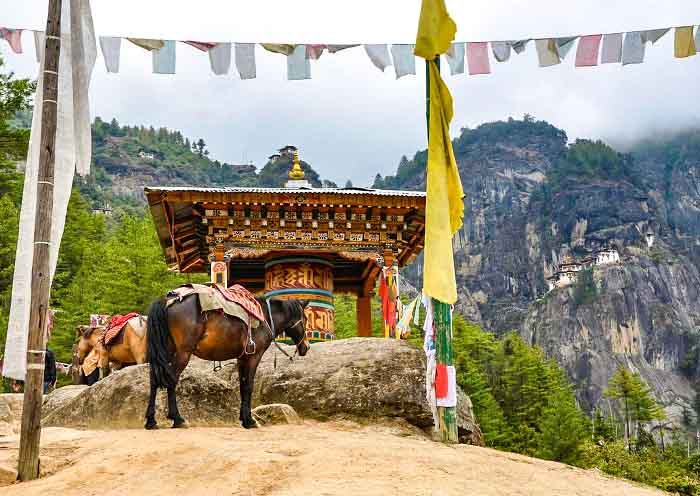

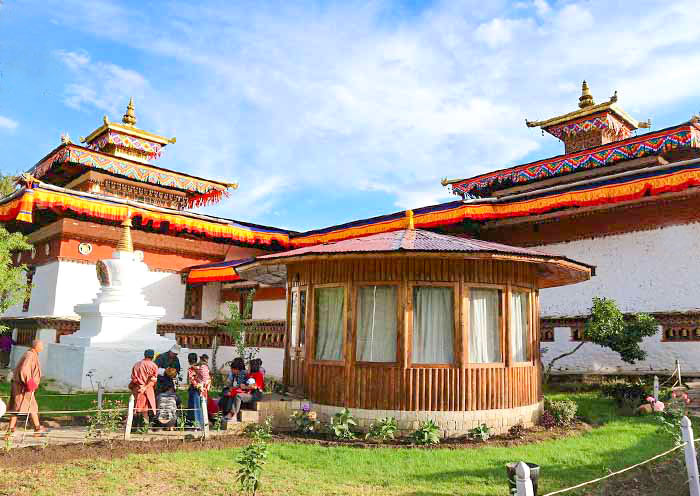
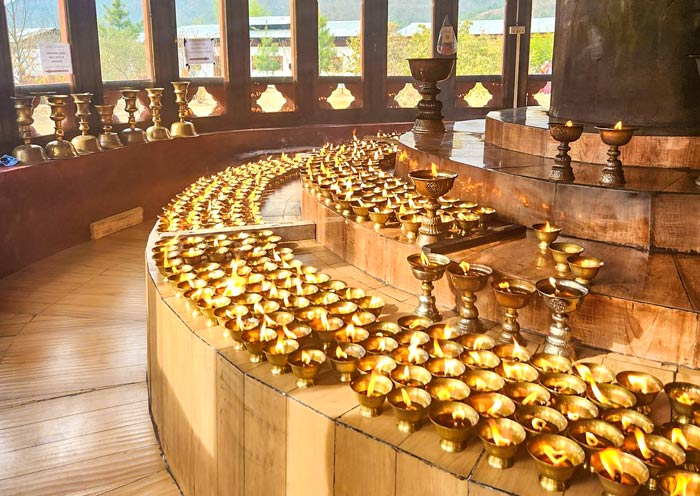
In the morning, you will embark on a drive to Shana, covering approximately 17 km on an unpaved road. Upon arrival, you will meet your trekking crew and begin your trek. This will be a long day of hiking, with the trail encompassing various small inclines and declines. As you make your way uphill through the river valley, the landscape gradually narrows, leading you to a narrow path. Eventually, you will descend to a picturesque meadow where the campsite, situated at an altitude of 3,750m, will be set up. If the weather permits, you will be treated to the first magnificent view of Mt. Jumolhari.
You will spend the night at the campsite in Sio Thangthangkha.
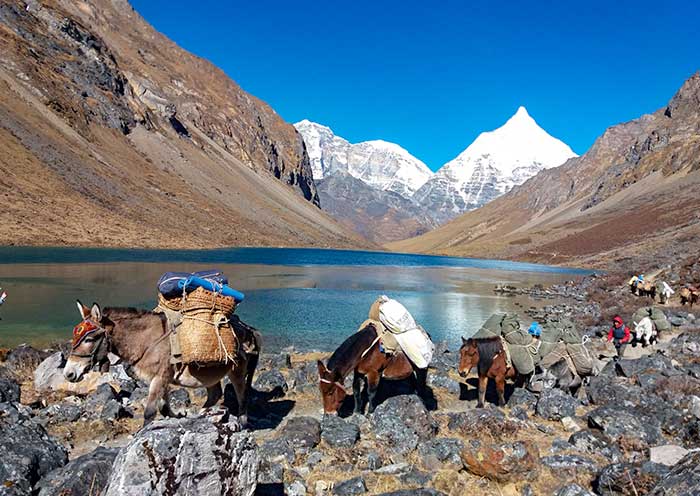

Today's trek takes you through the picturesque Paro Chuu Valley. As you venture forward, the trail winds through an enchanting alpine meadow before leading you into a dense forest. Along the way, you will encounter an army outpost where you'll need to pause and complete the necessary registration for entry permits. Rest assured, your guide will take care of the Bhutan entry permit on your behalf.
Continuing alongside the tranquil Pachu River, you will pass by charming villages such as Sio, Takethang, and Dangochang. This particular day holds immense significance as you arrive at the Jangothang Base Camp, located at an elevation of 4,050m. As the sun begins to set, the awe-inspiring views of Mt. Jomolhari will mesmerize you. The abundant flora and fauna found in this region add to the allure, with the sweet melodies of chirping birds filling the air. Keep an eye out for fascinating species like the Yellow-billed Chough, Fire-tailed Sunbird, White-throated Dipper, and Snow Partridge, among others. However, the true highlight of today's trek is the panoramic sight of the snow-capped peaks of Jomolhari, Jichu Drake, and the graceful flight of ravens.
Prepare to spend the night at the campsite in Jangothang, surrounded by the majestic beauty of the Bhutanese wilderness.


On this particular day, you will have the opportunity to take a well-deserved break at Jangothang. There are plenty of small activities to enjoy during your rest day. You can opt for a leisurely hike around the stunning nearby landscapes or even venture up to Tsophu Lake for a refreshing change of scenery. The beauty of Jangothang is further enhanced by the distant views of Jomolhari and Jichu Drake, which add an element of grandeur to the surroundings. For an even better view of Jomolhari, consider trekking a bit further up.
While exploring the area, you may come across blue sheep gracefully grazing on the upper slopes of the valley. Keep an eye out for other fascinating wildlife encounters, such as the Himalayan Rhubarb, Golden Eagles, and the exquisite Himalayan Blue Poppy - the national flower of Bhutan. Taking this day to rest is crucial for acclimatizing your body to the sudden change in altitude. After several days of challenging trekking, this well-deserved rest day is truly a blessing.
As the day comes to a close, you will once again spend the night at the campsite in Jangothang, surrounded by the serenity of the Bhutanese wilderness.
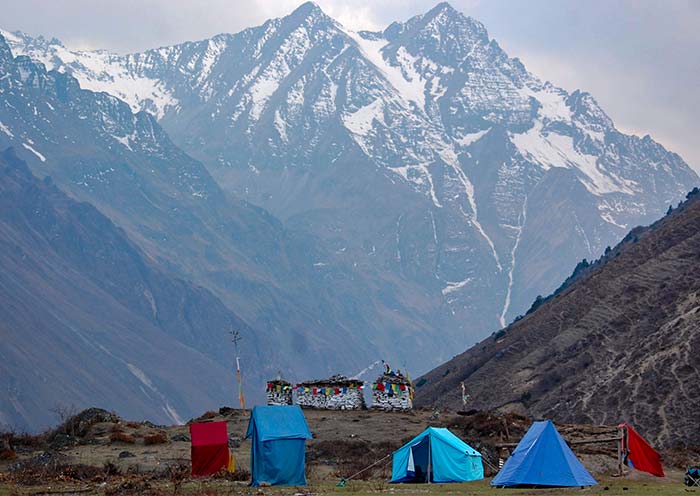
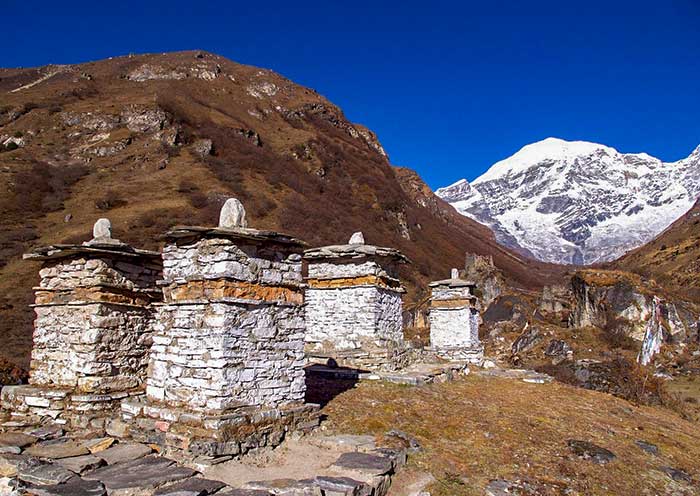
On this day, you will embark on a journey to Lingshi, covering a distance of approximately 19km. The trail begins with a challenging ascent above the base camp, leading you through glacial moraine. The sight of Jomolhari and Jichu Drake will appear in a different light as you make your way forward. Walking along a snowy path, you will reach the magnificent Nylie La pass, situated at an altitude of 4830m. Here, you will experience a cold and invigorating wind that rushes down from the mountains. Prepare to be awestruck by the panoramic view of Tshering Gang, proudly standing at a towering height of 6,789m.
The trek becomes slightly more demanding as you descend towards the Lingshi campsite. From your camp, you will be treated to breathtaking views of majestic peaks and the captivating Lingshi Dzong. Lingshi is a monastery that serves as the administrative office of the Drungpa. The tranquility and serenity that surround this sacred place are unparalleled.
As the day draws to a close, you will spend the night at the campsite in Lingshi, immersed in the serene beauty of the Bhutanese landscape.
Today, you will embark on a long and rewarding trek that spans approximately 9 hours and covers a distance of 22 km, ultimately leading you to Shodu. The trail commences with an uphill climb to a ridge adorned with a chorten, offering panoramic vistas of the Mo Chhu valley. Crossing a river, you will ascend to the Yeli La pass, situated at an impressive altitude of 4,820m/15,813ft. As you continue, the landscape becomes sparsely populated, providing magnificent views of the snow-capped peaks of Jomolhari, Gangchen Ta, Tshering Gang, and Masangang. The path gradually narrows, eventually leading you to Jimenameshing.
From there, the trail gradually descends, guiding you through a meadow until you reach the campsite in Shodu. This destination serves as a convergence point for numerous other treks, as it marks the main trail back to Thimphu. As you settle into the campsite, take the opportunity to relax and rejuvenate. Enjoy a steaming bowl of soup and engage in pleasant conversations with fellow trekkers, sharing in the camaraderie of the trekking experience.
You will spend the night at the campsite in Shodu, surrounded by the tranquil beauty of the Bhutanese wilderness.
Now, you will retrace your steps back to the tree line, transitioning from the higher alpine regions. The path meanders alongside the Thimphu River, gradually descending through picturesque landscapes adorned with vibrant rhododendron, juniper, and other alpine forests. As you progress, be prepared to be captivated by the awe-inspiring sight of cliff-facing rocks and cascading waterfalls.
A delightful hot lunch will be served riverside, providing a much-needed break and an opportunity to refuel. After replenishing your energy, the trail begins a gentle ascent towards the ruins of Barshong Dzong. In ancient times, this fortress served as a crucial supply base for Lingzhi Dzong. As you set up camp in Barshong, located at an altitude of 3600m, take a moment to appreciate the historical significance of the surroundings and the remnants of the dzong.
You will spend the night at the campsite in Barshong, immersed in the tranquility of the Bhutanese wilderness, surrounded by the whispers of nature.
Following a satisfying breakfast, a short and leisurely stroll of approximately half a kilometer awaits, taking around 15 minutes, leading you to the road point. At this juncture, your car will be ready and waiting to transport you to Thimphu, marking your return to civilization. Upon arrival, you can rejoice in the comforts of a well-appointed hotel and indulge in a rejuvenating shower, washing away the remnants of your adventurous journey.
As for today’s dinner, you can enjoy a traditional meal at the Folk Heritage Museum. The museum was established in 2001 through the initiative of Her Majesty Ashi Dorji Wangmo Wangchuck, the Queen Mother of Bhutan. It is housed in a three-storied, 19th-century traditional house, offering visitors a glimpse into the traditional Bhutanese lifestyle. The museum showcases artifacts from rural households, including a collection of typical household objects, tools, and equipment. After dinner, you will spend the night in Thimphu and have a restful sleep.
You will spend the night in Thimphu, relishing the convenience and amenities of the hotel, as you unwind and reflect upon the memorable experiences of your trek.
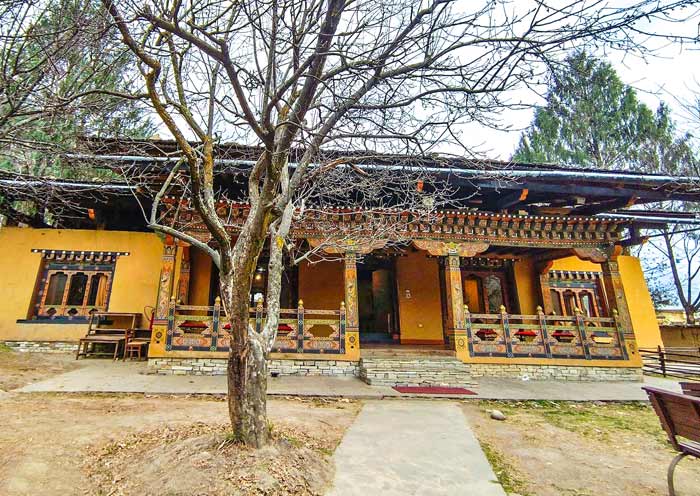
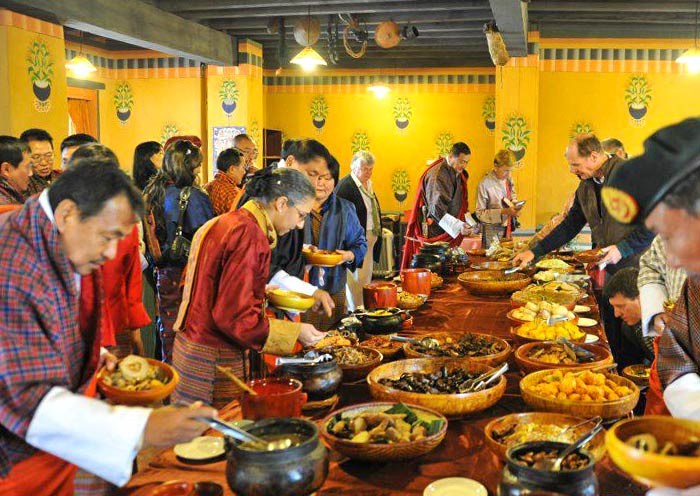
On this day, you will have a full day of sightseeing in Thimphu. You can explore its rich cultural heritage such as the Buddha Dordenma Statue, National Memorial Chorten, and Tashichho Dzong. Nature lovers will love to visit the Motithang Takin Preserve to see Bhutan's national animal. Additionally, you have the opportunity to learn more about Bhutanese culture by having dinner at the Folk Heritage Museum (available for groups of over 5 people).
First, you will visit the iconic landmark of Thimphu city - the Buddha Dordenma Statue (Buddha Point), which is the largest sitting Shakyamuni statue in the world. Completed in 2015, the statue embodies an ancient prophecy of radiating happiness and peace throughout the world. In addition to admiring its impressive height of 51.5 meters, constructed of bronze and gilded in gold, you will also be able to see 125,000 smaller Buddha statues placed within it. Moreover, from this vantage point, you can enjoy a magnificent view of the Thimphu Valley.
As the largest city in Bhutan, Thimphu lacks traffic lights and a railway system. When you enter the city, you can visit the National Memorial Chorten and experience it as the locals do. It is customary to follow the footsteps of the Bhutanese people and perform a clockwise kora (circumambulation) around the Chorten while offering prayers. This will provide you with numerous opportunities to engage with the locals and learn about their daily lives, as well as their philosophy on happiness.
The National Memorial Chorten is the most visited landmark in Thimphu. Constructed in 1974 in memory of the Third King, His Majesty Jigme Dorji Wangchuk (known as the Father of Modern Bhutan), by his mother, it reflects the late king's vision of promoting world peace and prosperity. The Chorten follows a Tibetan-style architecture and is adorned with remarkable paintings and intricate sculptures. You can observe the traditional stupa design, featuring a pyramidal pillar topped with a crescent moon and sun. If time permits and you have an interest in Bhutan's national animal, you can visit the Motithang Takin Preserve. There, you can observe the unique creature that is said to have been created by the legendary Drukpa Kunley (Divine Madman). According to legend, Drukpa Kunley fashioned the takin with the head of a goat and the body of a cow.
Sure, you should not miss the visit to Tashichho Dzong (Thimphu Dzong), which has served as the seat of the government since 1952. This magnificent fortress-like structure is located on the western bank of the Wang Chu River. It seamlessly integrates with the entire valley and stands as the ultimate center of power in Bhutan. It houses the offices of the current reigning monarch, the Fifth King (Jigme Khesar Namgyel Wangchuck), as well as the ministries of internal affairs and finance. Additionally, it serves as the residence of the spiritual leader of Bhutan, the Je Khenpo, and hosts the central religious institutions of the country. During the summer season, the Je Khenpo resides in the Thimphu Dzong, while in the winter season, they relocate to Punakha Dzong. Walking around the Dzong, you will discover that it is an impressively large structure surrounded by well-kept lawns and beautiful gardens. Tashichho Dzong has two main entrances. One entrance leads to the administrative section in the south, while the other, situated in the north, grants access to the monastic quarter where the Thimphu Tshechu festival and masked dances are performed.
Optional Bhutan Thimphu Experiences:
Fully functional stamp printed with a self-portrait (Bhutan Post Office: Weekdays: 9AM - 5PM; Saturdays: 9 AM - 1 PM; Closed on Sundays)
Cooking class in Thimphu (1hour).
After the tour, be transferred from Thimphu to Paro.
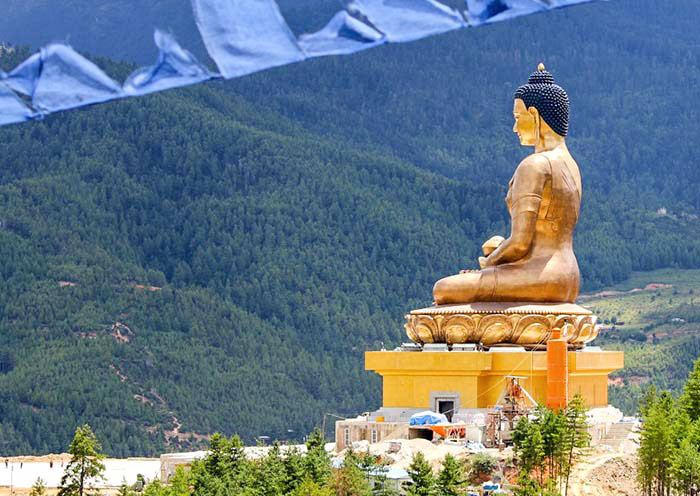
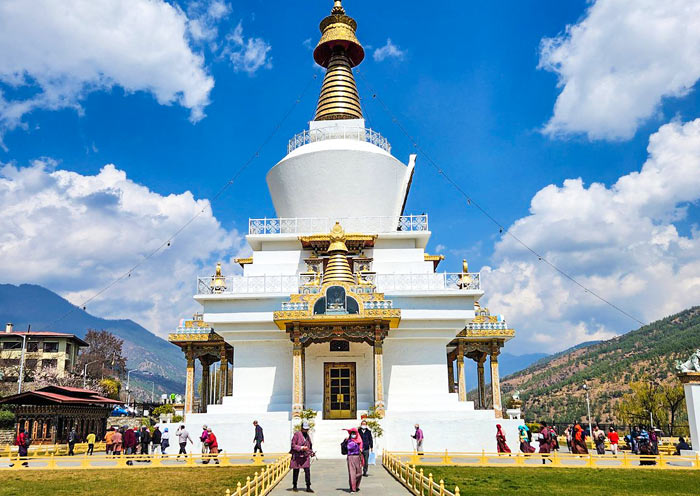


Happiness is a place, wish you had gotten your happiness philosophy from the beautiful Himalayan country with us. It is time to end your 11-day Bhutan Trekking Tour. Your guide will escort you to Paro International Airport for your flight to your next destination.
Extension Ideas:
1.If you prefer to travel longer in Bhutan, you can extend your trip to other highlighted parts of Bhutan, such as Punakha, Gangtey, Haa, and Bumthang.
2.If you plan to continue exploring neighboring countries in Southeast Asia, the Himalaya countries, or Asia, such as Thailand, Nepal, India, or China, don't hesitate to let us know. We can customize your itinerary and assist with travel arrangements.
Thank you for choosing Asia Odyssey Travel (AOT) for your Bhutan tour, we are always here working for you and hope to see you again for your next trip to China/Asia. Safe journey!

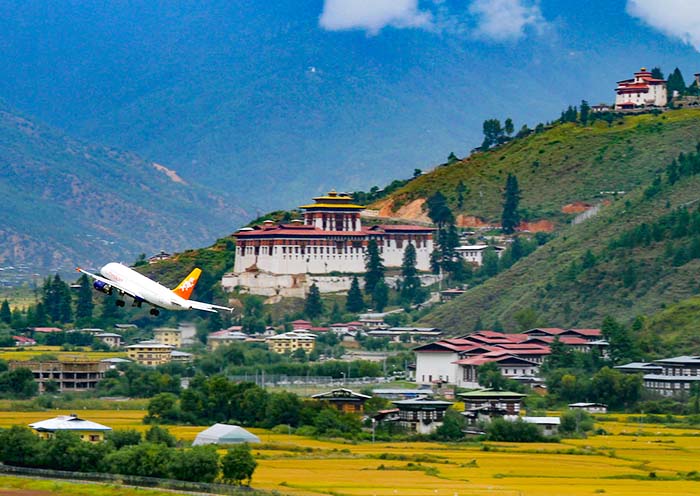
Price: What’s Included & What’s Excluded
What’s Included:
What’s Excluded:
Important Travel Tips for Visiting Bhutan
Please note that full payment of the tour fee is required 30 days before the departure date. The tour fee should be transferred to the account of the Royal Bank of Bhutan. Once the payment is received, the Bhutanese government will process your visa.
A Bhutan Group Tour typically involves traveling with a group of 1 to 12 travelers. During the tour, you will follow a set schedule and participate in activities as planned by us. The hotel arrangements for Group Tours in Bhutan are based on a 3-star level, making them more budget-friendly compared to private tours. We offer 9 group tours ranging from 4 to 11 days in duration.
On the other hand, a Bhutan Private Tour is designed to cater to your specific preferences and requirements. With a Private Tour, you have greater control over the itinerary, allowing you to customize it according to your interests and preferred pace. Additionally, you can choose the hotel condition, whether it be luxury or budget, based on your preferences. We offer Bhutan private tours with different themes, and you can choose from tours lasting 3 to 11 days.
The ideal seasons for traveling in Bhutan are from March to November, when the weather is most suitable for visitors. During the off-peak season, which lasts from December to February, it is winter in Bhutan. Daytime temperatures hover around 15 degrees Celsius, and at night, they drop below freezing. From June to September, it is the summer and rainy season, with daytime temperatures around 23 degrees Celsius and nighttime temperatures around 15 degrees Celsius.
On the other hand, the peak travel periods are from March to May and from September to November.
Bhutanese cuisine prominently features chili as its main ingredient, with most dishes incorporating cheese, potatoes, and chili. Vegetables primarily consist of legumes and tubers. If you have any dietary restrictions or special meal requirements, please inform us during the tour registration process so that we can make appropriate meal arrangements.
In the Paro region of Bhutan, staple foods include rice, buckwheat, corn, and red rice. Chili and dairy products are commonly used as accompaniments. One of the most famous traditional dishes is Ema Datshi, which consists of chili with cheese. While beef, lamb, and pork are popular meats, it's important to note that Bhutan follows Buddhist principles of non-violence and does not slaughter animals within the country. Most of the meat available in the market is imported from neighboring India and primarily caters to tourists. Beverage options include black tea, butter tea, rice wine, and beer.
Hotel Conditions for Your Bhutan Tour




In Paro, Thimphu, Punakha and other destinations in Bhutan, there are several well-positioned 4-star hotels that offer convenient access to popular attractions and ensure a comfortable stay.
1. Upgrading Hotel Accommodation: If you desire a higher standard of accommodation, our travel experts can provide you with alternative pricing options for hotel upgrades. Whether you prefer a more luxurious experience or have specific preferences, the experts will assist you in making the best choice to suit your needs.
2. Check-In and Check-Out Times: Check-in time for the hotels is generally after 14:00 (2:00 PM), allowing you to settle in and freshen up before starting your Bhutanese adventure. On the day of departure, please check out before 12:00 noon to ensure a smooth transition and allow time for the hotel staff to prepare for incoming guests.
Photo Gallery for This Itinerary
Latest Bhutan Tours Reviews from Our Customers

cindy heng
Malaysia
Date of Experience: Sep 07, 2025
Tour Customized by: Abby
You May be Interested in This Tour: Customized Tour

mui m
Vietnam
Highly recommend Asia Odyssey - they planned a fantastic itinerary against our brief for Tibet, Nepal, and Bhutan. Special shoutout to Ms. Mandy who planned our trip, answered all our questions, was incredibly responsive, and was always helpful. She checked in during our trip to make sure we were okay as well. On our trip, our local guides were knowledgeable and kind and our accommodation was comfortable. All-in-all a fantastic experience and highly recommended.
Thank you for a wonderful experience!!
Destination(s): Tibet
Date of Experience: Jun 05, 2025
Tour Customized by: Mandy
You May be Interested in This Tour: Customized Tour

Bhawani Thangaratnam
Malaysia
Date of Experience: Aug 31, 2025
Tour Customized by: Steven
You May be Interested in This Tour: Customized Tour
Price: Request
(Based on a private tour for two people. Price varies depending on program, travel date, number of people.)
Free Enquiry! You don’t need to pay for the reservation.
- United States (+1)
- Australia (+61)
- Singapore (+65)
- Malaysia (+60)
- Philippines (+63)
- Canada (+1)
- Italy (+39)
- Indonesia (+62)
- United Kingdom (+44)
- Spain (+34)
- Mexico (+52)
- Hong Kong (+852)
- Thailand (+66)
- United Arab Emirates (+971)
- New Zealand (+64)
- South Africa (+27)
- Germany (+49)
- Brazil (+55)
- India (+91)
- France (+33)
- Vietnam (+84)
- The Netherlands (+31)
- Saudi Arabia (+966)
- Ireland (+353)
- Argentina (+54)
- Switzerland (+41)
- Romania (+40)
- Pakistan (+92)
- Japan (+81)
- Portugal (+351)
- Bangladesh (+880)
- South Korea (+82)
- Puerto Rico (+1)
- Türkiye (+90)
- China (+86)
- Belgium (+32)
- Qatar (+974)
- Greece (+30)
- Taiwan (+886)
- Austria (+43)
- Poland (+48)
- Israel (+972)
- Chile (+56)
- Sri Lanka (+94)
- Nigeria (+234)
- Peru (+51)
- Colombia (+57)
- Hungary (+36)
- Nepal (+977)
- Denmark (+45)
- Bulgaria (+359)
- Norway (+47)
- Slovenia (+383)
- Sweden (+46)
- Kuwait (+965)
- Costa Rica (+506)
- Ecuador (+593)
- Venezuela (+58)
- Malta (+356)
- Croatia (+385)
- Tunisia (+216)
- Czechia (+420)
- Mongolia (+976)
- Bahrain (+973)
- Mauritius (+230)
- Papua New Guinea (+675)
- Cambodia (+855)
- Dominican Republic (+1)
- Luxembourg (+352)
- Finland (+358)
- Guatemala (+502)
- Myanmar (+95)
- Maldives (+960)
- Slovakia (+421)
- Laos (+856)
- Serbia (+381)
- Brunei (+673)
- Oman (+968)
- Macao (+853)
- Panama (+507)
- Morocco (+212)
- Jordan (+962)
- Georgia (+995)
- Fiji (+679)
- Bolivia (+591)
- Lithuania (+370)
- Bahamas (+1)
- Cyprus (+357)
- Latvia (+371)
- Bhutan (+975)
- Iraq (+964)
- Iran (+98)
- Kenya (+254)
- Jamaica (+1)
- Zimbabwe (+263)
- Azerbaijan (+994)
- Uruguay (+598)
- Estonia (+372)
- Andorra (+376)
- Cameroon (+237)
- Ghana (+233)
- Kazakhstan (+7)
- Nicaragua (+505)
- Egypt (+20)
- Russia (+7)
- Albania (+355)
- Réunion (+262)
- Montenegro (+382)
- Algeria (+213)
- Afghanistan (+93)
- Martinique (+596)
- Uganda (+256)
- Honduras (+504)
- North Macedonia (+389)
- Trinidad and Tobago (+1)
- Suriname (+597)
- Antigua and Barbuda (+1)
- Zambia (+260)
- Ukraine (+380)
- Armenia (+374)
- Barbados (+1)
- Belarus (+375)
- Palestine (+970)
- Lesotho (+266)
- Moldova (+373)
- Ethiopia (+251)
- French Polynesia (+689)
- Gambia (+220)
- Guam (+1)
- Gibraltar (+350)
- Isle of Man (+44)
- New Caledonia (+687)
- El Salvador (+503)
- Comoros (+269)
- Seychelles (+248)
- Chad (+235)
- Samoa (+685)
- Cook Islands (+682)
- Palau (+680)
- Paraguay (+595)
- DR Congo (+243)
- Solomon Islands (+677)




